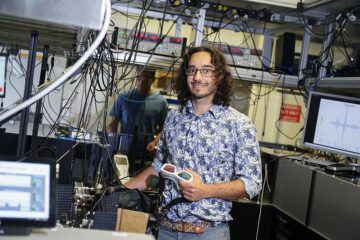Bose-Einstein-Light (BEL) – Generation of coherent light of high intensity in a solid state “cold Laser”

Lasers as sources for coherent and intense light are used in many high-tech applications and medical devices. Generally, the generation of Laser-light is characterized by a significant level of optical and electrical energy input and low efficiency.
Contrary to the Laser, BEL utilizes an organic dye/polymer system, which is arranged between two mirrors forming an optical micro-cavity. The incoming light is multiply reflected between the mirrors, giving rise to an effective photon mass and a confining potential – key prerequisites for the Bose-Einstein condensation of photons. Thermalisation is achieved by the photon scattering off the dye molecules, resulting in a strong light concentration effect into the centre of the confining potential, where the potential energy is minimized. The spatial concentration is a consequence of the thermalisation of the trapped photon gas. Commercial Opportunity: For many Laser applications, coherent but not necessarily monochromatic light is required. The strong light concentration effect of BEL and the generation of coherent light with high intensity offer opportunities for a range of applications. For these applications, BEL can be a efficient light source for coherent visible and UV light. In contrast to a Laser, where significant share of the energy is lost in heat, BEL allows the design of an efficient solid state “cold Laser”.
Weitere Informationen: PDF
PROvendis GmbH
Tel.: +49 (0)208/94105 10
Ansprechpartner
Dipl.-Ing. Alfred Schillert
Media Contact
Alle Nachrichten aus der Kategorie: Technologieangebote
Neueste Beiträge

Neue universelle lichtbasierte Technik zur Kontrolle der Talpolarisation
Ein internationales Forscherteam berichtet in Nature über eine neue Methode, mit der zum ersten Mal die Talpolarisation in zentrosymmetrischen Bulk-Materialien auf eine nicht materialspezifische Weise erreicht wird. Diese „universelle Technik“…

Tumorzellen hebeln das Immunsystem früh aus
Neu entdeckter Mechanismus könnte Krebs-Immuntherapien deutlich verbessern. Tumore verhindern aktiv, dass sich Immunantworten durch sogenannte zytotoxische T-Zellen bilden, die den Krebs bekämpfen könnten. Wie das genau geschieht, beschreiben jetzt erstmals…

Immunzellen in den Startlöchern: „Allzeit bereit“ ist harte Arbeit
Wenn Krankheitserreger in den Körper eindringen, muss das Immunsystem sofort reagieren und eine Infektion verhindern oder eindämmen. Doch wie halten sich unsere Abwehrzellen bereit, wenn kein Angreifer in Sicht ist?…

















